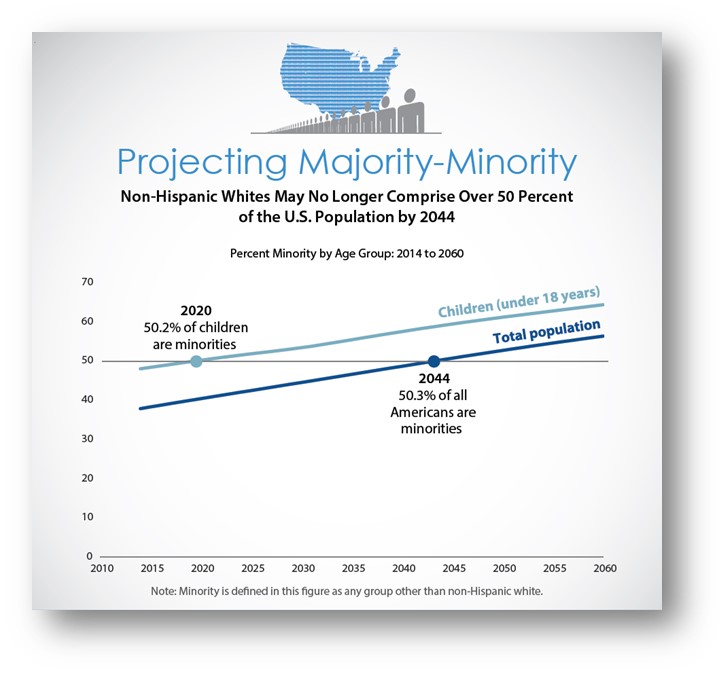We are facing a dynamic and consistent cultural shift in the U.S.
Population research conducted by the U.S. Census Bureau indicates that by 2020 over 50% of the children in the U.S. will be majority-minority, and by 2044 the general adult population will follow suit. The leadership terms, training and methods made successful so many years ago will most likely have to adapt to the cultural shift in the workforce in order to maintain relevancy in a continually culturally diverse workplace.
HR and TA experts will have to develop and grow in the area of cultural competency. Current buzzwords such as diversity and inclusion, will become statements of fact and become the norm in that near future for any organization.
To ensure competitive advantage HR and TA professionals need to be aware of the new cultural dynamics and become competent in the cultural diversity of the workforce of the future.
What is cultural competency? According to the Business Dictionary, it is:
“A set of behaviors, policies, and attitudes which form a system or agency which allows cross-cultural groups to effectively work professionally in situations. This includes human behaviors, languages, communications, actions, values, religious beliefs, social groups, and ethic perceptions. Individuals are competent to function on their own and within an organization where multi-cultural situations will be present.”
The fact is, if your organization is not culturally diverse today, it will certainly be in the years to come. Research indicates that countries with a high influx of immigrant workers show growth in their available workforce, whereas countries with no immigrant influx population are seeing a decline in available workforce population. In his book Diversity Explosion: How New Racial Demographics are Remaking America W.H. Frey discusses how the United States labor workforce population has increased by 5%, but without our immigration policies it would have decreased by 8%. In contrast, Japan, a country with no immigration policy or plan will suffer an estimated 15% decrease in their available workforce population between 2010-2030.
How do you practice cultural competency?
How does an organization practically apply cultural competency then? In part, it’s by providing a culture that fosters relationships across the organization. HR and TA professionals will play a pivotal role in ensuring the organizational success of such relationships. They will also need to learn about the cultural nuances that apply to different cultures, and lead by example. We, as HR professionals, also need to demonstrate our willingness to learn and appreciate what the diversity of culture brings to any organization.
Another aspect of the practical application of cultural competency is to understand the current cultural norms associated with the various individuals in your workforce.
Marjorie Derven wrote in an article in TD: Talent Development, “Diversity means inviting a mix of people to the party; inclusion means everyone dances together.” Derven goes on to discuss how the world’s most innovative companies today, are on average, “4 times more likely to focus on diversity and inclusion.” See, diversity and inclusion (D&I) are not just buzzwords or monthly emails sent out from the leadership. D&I need to be ingrained in the culture in order to ensure teams can effectively communicate.
Relationships build understanding
Relationships across the organization spanning cultures are the essential tool needed to reduce stereotypes and preconceived notions.
In a study by Peter Cardon, for the Thunderbird International Review, the author discusses the concept of ‘saving face.’ Specifically, he sheds light on how businesses in China have a very detailed set of cultural behaviors involved with the concept of saving face. Cardon discusses how there are very different “dominant face practices” that change among relationships in the organization. These relationships can be broken down into horizontal insider relationships, vertical insider relationships, and outsider. Clearly, in such a work environment it is imperative that everyone in the organization have an understanding of the different cultural nuances involved.
Everyone in the organization needs to get this, and participate. In my 20 years of naval service, I had the opportunity to work with different cultures in over 12 different countries. From that experience I can tell you, if you are not fully honest in your effort to learn another’s culture, the members of your organization will notice that disingenuous behavior.
Changes in the American workforce are coming, and these changes are good. As leaders, we simply need to ensure that the leadership training and mentoring we provide today meets the needs for a diverse and inclusive workforce. Cultural diversity is the exciting and innovative new norm, and we need to make sure our organizations are prepared to thrive in today’s global workforce.
